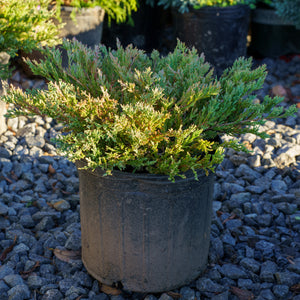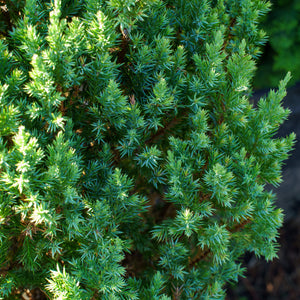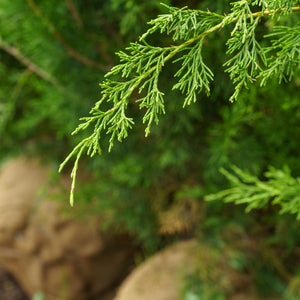The Juniper Guide
Junipers (genus Juniperus) are evergreen conifers found in a wide range of landscape applications—from low-growing groundcovers to towering vertical accents. Prized for their year-round color, drought tolerance, and adaptability, junipers are available in many shapes, textures, and shades of green, blue, and gold. Their durability and minimal maintenance needs make them ideal for modern landscapes, rock gardens, slopes, privacy screens, and formal hedges.
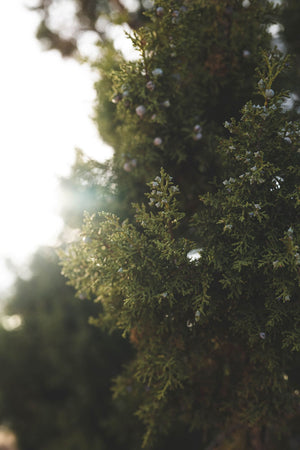
About
The Juniperus genus encompasses over 70 species of shrubs and trees, many of which are used ornamentally in North America. These versatile plants thrive in full sun and poor soils and offer visual structure across seasons, often filling gaps where other plants struggle.
Popular species and their cultivars include:
- Juniperus chinensis (Chinese Juniper): Versatile, with cultivars like ‘Spartan’ (upright), ‘Sea Green’ (fountain-shaped), ‘Old Gold’ (gold foliage), and ‘Keteleeri’ (pyramidal form).
- Juniperus procumbens (Creeping Juniper): Ground-hugging, slow-growing types like ‘Nana’ and ‘Green Mound’ are excellent for bonsai, containers, and erosion control.
- Juniperus horizontalis (Creeping Juniper): Cold-hardy and spreading, with cultivars like ‘Blue Chip’, ‘Wiltonii’, and ‘Mother Lode’ adding texture to slopes and borders.
- Juniperus virginiana (Eastern Redcedar): Native to the U.S., with upright selections like ‘Skyrocket’, ‘Taylor’, and ‘Blue Arrow’ used for screening and vertical structure.
- Juniperus scopulorum (Rocky Mountain Juniper): Noted for blue foliage and vertical habit, including ‘Moonglow’ and ‘Wichita Blue’.
- Juniperus squamata: Finely textured foliage in cultivars like ‘Blue Star’, ‘Blue Carpet’, and ‘Holger’.
Junipers are conifers, producing small cones—often mistaken for berries—that serve as a food source for birds and wildlife. Their rich diversity in form, foliage, and function has made them a staple in low-maintenance and drought-tolerant landscapes.
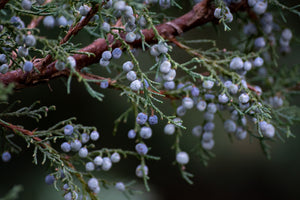
PLANTING
Junipers thrive in tough conditions and are one of the most forgiving evergreens to establish.
USDA Hardiness Zones: Zones 3–9, depending on species. Most varieties used ornamentally fall within Zones 4–8.
Soil: Well-drained soil is essential. Junipers tolerate sandy, rocky, and poor soils but are prone to root rot in wet or heavy clay conditions.
Sunlight: Full sun is required for healthy growth, dense foliage, and rich color. At least 6 hours of direct sun daily is ideal.
Watering: Junipers are drought-tolerant once established. Water regularly during the first year to promote deep roots, then reduce frequency. Avoid overwatering.
Spacing:
- Groundcovers: 3–5 feet apart
- Upright shrubs: 5–8 feet apart depending on mature width
- Tall screens: 6–10 feet apart
Planting Time: Plant in early spring or fall when temperatures are moderate. Container-grown plants can be planted anytime the ground is workable.
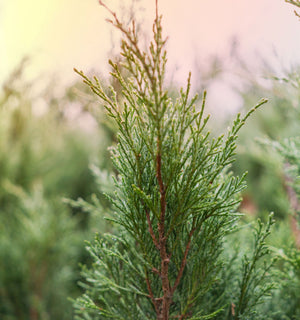
CARE
Junipers are among the lowest-maintenance plants available for landscape use. With a few basic practices, they will thrive for decades.
Watering: Minimal after establishment. Supplement during prolonged droughts or excessive heat.
Fertilizing: Not usually required. If desired, apply a balanced slow-release fertilizer in early spring.
Pruning:
- Light pruning can be done anytime to shape or control size.
- Avoid cutting into old wood, as junipers do not regenerate from bare stems.
- Use shears or hand pruners to trim new growth rather than hedging deeply.
Pests & Diseases: Relatively pest-resistant. Occasional issues include spider mites or blight in humid climates. Ensure good air circulation and avoid wetting foliage.
Mulching: Use a light layer of mulch to conserve moisture and reduce weeds, keeping mulch several inches away from stems.
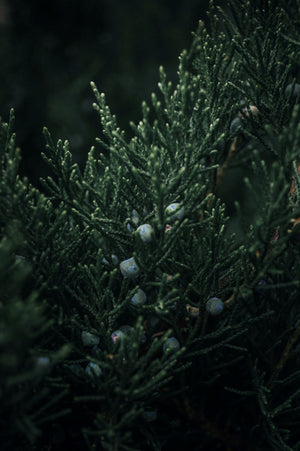
HOW TO USE
Few plants offer the design flexibility of junipers. Their variety in shape and scale makes them essential in formal and informal settings, with applications ranging from erosion control to living sculpture.
Focal Point: Use upright cultivars like ‘Blue Point’, ‘Spartan’, or ‘Moonglow’ as focal point evergreens in foundation plantings, entryways, or formal gardens. Their vertical habit and distinctive color draw attention year-round.
Groundcovers and Slopes: Low-growing varieties such as ‘Blue Pacific’, ‘Wiltonii’, and ‘Mother Lode’ provide dense, weed-smothering coverage. These are ideal for erosion control, rock gardens, or sunny hillsides.
Formal Hedges and Screens: Columnar types like ‘Skyrocket’, ‘Taylor’, and ‘Blue Arrow’ create fast-growing privacy screens with a narrow footprint. Space evenly and prune lightly to maintain clean lines.
Foundation and Border Plantings: Mounding forms like ‘Sea Green’, ‘Old Gold’, or ‘San Jose’ add evergreen mass and soft texture around homes or mixed shrub borders. Their reliability and drought tolerance make them excellent background plants.
Containers and Courtyards: Compact types like ‘Blue Star’ or ‘Compressa’ work well in pots, adding structure and texture to patios and urban settings. Combine with seasonal color for year-round container displays.
Bonsai and Japanese Gardens: Juniperus procumbens ‘Nana’ and Juniperus chinensis ‘Shimpaku’ are popular in bonsai cultivation, appreciated for their fine needles and trainable form. Pair with stone and gravel for minimal, meditative landscapes.
Wildlife and Native Plantings: Juniperus virginiana and other native species provide food and shelter for birds and insects. Plant in naturalized areas or meadows for wildlife value.
Companion Planting: Pair upright junipers with ornamental grasses, daylilies, and salvia for low-water borders. In rock gardens, combine groundcover types with sedum, thyme, or creeping phlox for layered, sun-loving textures.
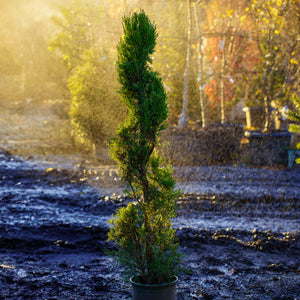
Common Questions
Are juniper berries edible? Some juniper species produce cones commonly called berries. While Juniperus communis berries are used in flavoring (like gin), others can be toxic or bitter. Do not consume unless the species is confirmed safe.
What does a juniper tree look like? Junipers vary widely. Tree forms like ‘Skyrocket’ or ‘Taylor’ are narrow and upright, while shrubs like ‘Sea Green’ form soft, mounded shapes. Groundcovers like ‘Blue Chip’ spread low with dense foliage. All feature needle-like or scale-like evergreen leaves.
How to care for a juniper bonsai tree? Provide bright light, well-drained soil, and careful pruning. Keep slightly moist but never soggy. Protect from extreme cold or intense heat depending on species. Train gradually using wiring and shaping techniques.
How to trim juniper bushes? Use hand pruners to remove overgrown branches, deadwood, or shape light new growth. Do not cut into older, brown wood, as junipers rarely regenerate from bare stems. Avoid heavy shearing.
Do deer eat juniper? Junipers are generally deer-resistant. They have aromatic foliage and a bitter taste, making them unattractive to deer in most areas.
Do rabbits eat juniper? Junipers are usually avoided by rabbits due to their texture and taste. However, young plants may be nibbled in winter when food is scarce.
Is juniper toxic to dogs? Yes, many juniper species are mildly toxic to dogs. Ingestion can cause stomach upset, vomiting, or diarrhea. Avoid letting pets chew foliage or berries.
Is juniper toxic to cats? Yes, juniper can be mildly toxic to cats if ingested. Symptoms include vomiting and gastrointestinal irritation. Monitor pets and plant accordingly.
Does juniper need full sun? Yes. Junipers require full sun (at least 6 hours per day) for dense growth, strong color, and disease resistance. Shade leads to thinning and poor form.
Conclusion
Junipers offer dependable evergreen structure, low maintenance, and wide versatility across climates and garden styles. Whether you're covering slopes, defining entryways, or creating living privacy walls, junipers provide an enduring solution with minimal upkeep. With options ranging from bold focal points to sprawling groundcovers, these conifers remain essential tools in residential and commercial landscape design.

